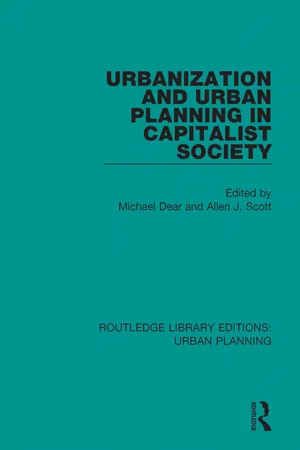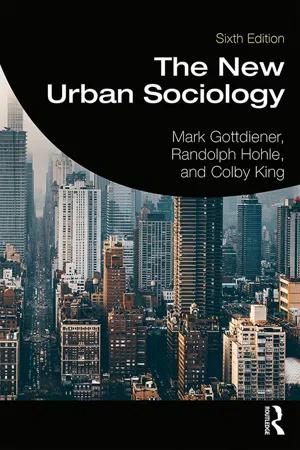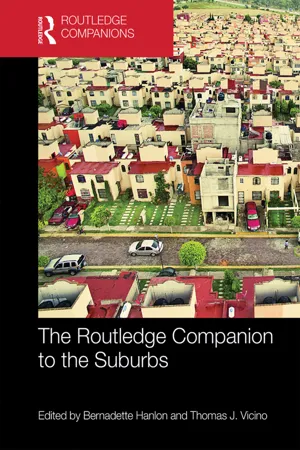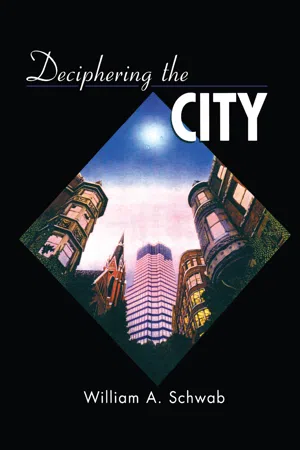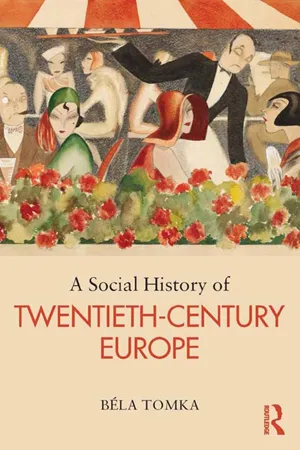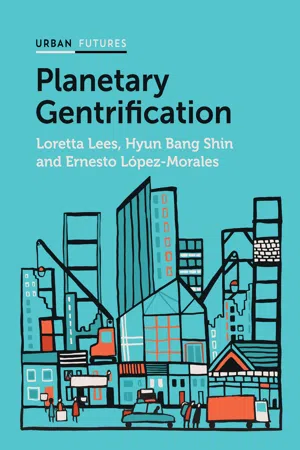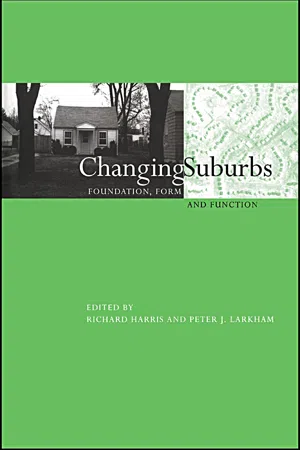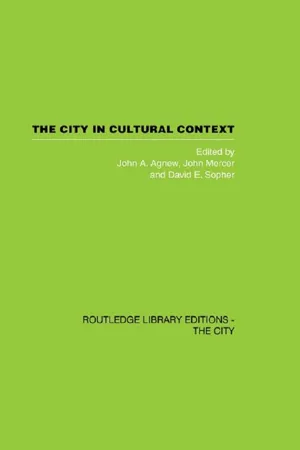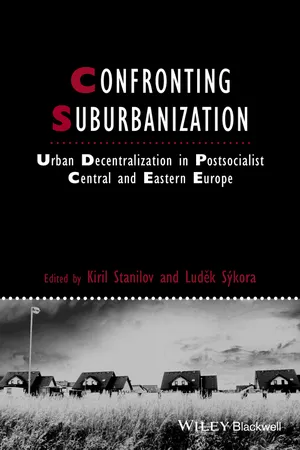History
Suburbanization
Suburbanization refers to the process of population movement from urban areas to suburban areas on the outskirts of cities. This trend gained momentum in the 20th century, driven by factors such as improved transportation and the desire for larger living spaces. Suburbanization has had significant social, economic, and environmental impacts, including changes in land use, transportation patterns, and community dynamics.
Written by Perlego with AI-assistance
Related key terms
Related key terms
1 of 4
Related key terms
1 of 3
10 Key excerpts on "Suburbanization"
- Michael Dear, Allen Scott, Michael Dear, Allen J. Scott(Authors)
- 2018(Publication Date)
- Routledge(Publisher)
15 A theory of Suburbanization: capitalism and the construction of urban space in the United States Richard A. WalkerSuburbanization is clearly a process of enormous complexity, forming one part of the entire urbanization process, one aspect of the social whole. We approach it as a geographic problem, although it is not ‘in essence’ this any more than it is essentially an ‘economic’ or ‘sociological’ problem. Part of the difficulty in making sense of Suburbanization is the power of the myth that it can be defined in a purely geographic fashion, when, in fact, understanding spatial relations necessarily means confronting social relations as a whole.1As a geographic problem, modern Suburbanization has three major defining characteristics: spatial differentiation, decentralization, and identification with the waves of urban landscape laid down since the Second World War. Virtually everyone writing on the topic recognizes these three dimensions as empirically valid, with the disputes being over matters of degree and timing. The eminent historical geographer, J. Vance, for example, observes that ‘functional decongestion’ is ‘still the main dynamic force at work in our cities’ and that since the Second World War a ‘new city’ has come into being, which ‘differs in both scale and functional structure from the metropolis of pre-war days’.2 In fact, spatial differentiation, déconcentration and the phenomenon of successive, distinct waves of urbanization have been at work since the capitalist revolution transformed American cities in the nineteenth century and have become, in absolute terms, more pronounced over time. The principle difficulty, of course, is not descriptive specification of the three shaping forces but in coming up with a satisfactory explanation for them.3- eBook - ePub
- Mark Gottdiener, Randolph Hohle, Colby King(Authors)
- 2019(Publication Date)
- Routledge(Publisher)
merica is a suburban nation. It has been so since before the Great Depression. In fact, Suburbanization is not even unusual for industrialized countries. However, the massive scale and form of Suburbanization that has taken place since the 1950s makes Suburbanization in the United States quite distinctive among most societies, except for places like Australia and Canada. The form of contemporary Suburbanization that began in the 1950s is remarkable simply for the way it dominates urban space. The United States has assumed the urban form of single-family home construction for the middle class on an unprecedented scale. Contemporary Suburbanization in the United States is characterized by the deconcentration and restructuring of settlement space across the multicentered metropolitan region (MCMR). It is not a process of expansion emanating from a single central point, unlike the Chicago School’s Ernest Burgess’s theory. For decades, the areas outside the historical inner city have been the preferred destination of people and businesses. More people have lived in the suburbs than in the cities since 1970, and Suburbanization, in terms of population and size, continues to increase today. As discussed in the previous chapter, the current urban pattern of development, the MCMR, correlates with the present stage of political-economy, namely, global capitalism with its hyper mobility of capital investment, world labor sourcing and the desire of transnational corporations to develop land anywhere, not just in the historical central city.What is unique about contemporary Suburbanization? How and why did the 1950s usher in a new era of Suburbanization? Why do so many people choose to live there, especially after having children? To what extent are they deciding to move or stay in the suburbs, and to what extent are they guided or coerced into residing there? This chapter zeroes in on the most important characteristics and questions regarding Suburbanization. Before we discuss the changes that have taken place over the last six decades, let us first entertain the questions of choice and coercion and enticements producing Suburbanization and the multicentric metro region.STRUCTURE AND AGENCY IN THE HISTORY OF Suburbanization
Growth beyond city borders was a common feature of industrialized societies as early as the nineteenth century. In fact, the desire to live outside the city despite commuting there for work seems to be as old as the city itself. Although we can point to numerous writers who extol the virtues of city living, there has always been an expressed “anti-urban” bias in every urbanized civilization. The historian Kenneth Jackson offers the following excerpt from a letter written over 2,500 years ago as evidence that Suburbanization was a process coextensive with urbanization itself: - eBook - ePub
- Bernadette Hanlon, Thomas Vicino, Bernadette Hanlon, Thomas J. Vicino(Authors)
- 2018(Publication Date)
- Routledge(Publisher)
Both city and suburb are deceptive terms. They are both difficult to define precisely and are rather more a case of “we know one when we see one.” One composite definition developed recently by Harris and Larkham (1999, p. 8) provides a starting point for thinking about suburbs but also post-suburbs and processes of Suburbanization and post-Suburbanization. Harris and Larkham (1999, p. 8) provide a composite definition of a suburb as a settlement: 1) in a peripheral location relative to a dominant urban center; 2) partly or wholly residential in character; 3) of low-density of development; 4) with a distinctive culture or way of life; and 5) a separate community identity often embodied in a local government. The definition is a starting point as it arguably is exposed, just as definitions of the post-suburban can be, to the very process of urbanization it seeks to shed light on. The first element also forms the basis of Ekers et al. (2012, p. 407) definition of Suburbanization as “the combination of non-central population and economic growth with urban spatial expansion.” However, the outward expansion of cities renders the first definition highly relative – what was once peripheral comes to be regarded as central by virtue of the ongoing urbanization process. The second ingredient of the composite definition becomes problematic when we move beyond the Anglophone world, let alone beyond the Global North.The suburb has been an escape from the city in some societal contexts, and an approach to the city in others. Moreover, there are no easy area-based generalizations that can be made with respect to these two aspects of the suburb. Examples of the suburb as approach to and retreat from the city are both to be found within a single complex continent like Europe (Phelps and Vento, 2015). There are important commonalities between the suburbs of southern European cities and those in Latin American cities – and indeed across much of the Global South – in terms of the informality of their mode of development and their being an approach to the opportunities and services of cities.Perhaps a lowest common denominator that might integrate discourse on the suburb is that it is, in one or more senses, less than urban. If we accept this, we might also – although this is more controversial in some regards – accept the suggestion that, by the actions of their people and institutions, these settlements are in a process of becoming more urban. This is a question that has rarely been touched on in the literature (Bourne, 1996) and remains a largely vacant research agenda (see also McManus and Ethington, 2007). That is, rather than the suburb as a category, it is the process of (post)Suburbanization that needs to be considered (Ekers, Hamel and Keil, 2012). - eBook - ePub
- William A. Schwab(Author)
- 2020(Publication Date)
- Routledge(Publisher)
Many of these researchers were raised in the suburbs, and their background shaped their outlook just as the experiences of earlier generations shaped theirs. These newer cohorts, however, benefited from hindsight, and by testing the work of others, they achieved greater objectivity in their research. 1 The Suburbanization Process in Historical Perspective As we have seen, in the field of urban sociology a new generation of researchers has built on the work of the past to create a better understanding of Suburbanization. This same process is underway in urban history. By far the most important recent history on suburbia is Kenneth T. Jackson’s award-winning book, Crabgrass Frontier: The Suburbanization of the United States, published in 1985. Housing is one of the most telling artifacts of culture, and the theme woven throughout the work is that the way we have chosen to house our people is a reflection of our national character. Jackson argues that the suburbs that ring all our cities reflect the values and preferences that we as a people have always shared. Since colonial time, Americans have preferred detached dwellings to row houses, owning to renting, and rural to urban life. The suburbs represent a confluence of these values along with other technological and political factors. First, new building technology, especially the balloon or stick-built house, lowered the skill level of the labor needed to build homes and thus lowered housing costs. Second, changing transportation technology affected Suburbanization. Walking distances determined the size, density, and character of our earliest cities. In the nineteenth and twentieth centuries, a series of transportation innovations—first, the horse-drawn omnibus and the horse-drawn trolley, then the electrified trolley, and finally the automobile—revolutionalized accessibility and land costs. Third, this nation’s abundant resources, especially plentiful land and cheap energy, made suburbs as we know them possible - eBook - ePub
- Béla Tomka(Author)
- 2013(Publication Date)
- Routledge(Publisher)
12 Nevertheless, it has to be emphasized as well that this periodization is only of an approximate validity, not only because the demarcation lines of certain periods of social history rarely coincide with calendar decades, but also because even within Western Europe, these processes did not occur with the same intensity. They varied to such an extent that several of the terms referred to above generated heated debates among scholars, questioning their applicability and utility, and also raising the issue of whether in some cases, these concepts merely mask short, transitional phases, or particular developmental anomalies of certain regions or countries.SuburbanizationThe antecedents of Suburbanization can be traced back to the nineteenth century, because already at that time successful entrepreneurs and financiers preferred their stately homes to be built on the outskirts of industrial and commercial cities. The improvement of transport rendered it possible to increase the distance between the home and the place of work, so this type of urban habitat acquired an increasing popularity among wealthier citizens in the time to come.13In the interwar period, Suburbanization gained further impetus in some Western European countries: new, more loosely built districts appeared in the territories around cities, which primarily provided housing and lacked important urban functions. Consequently, these were closely connected to the urban core.In the interwar period, it was the development of garden suburbs that particularly advanced in England. These suburbs usually consisted of detached or row houses with small gardens, and were often constructed in order to provide homes for the not so well-off as well; the houses had a simple design and finish to make them more affordable. In addition, these projects also conformed to the Home Fit for Heroes - eBook - ePub
- Loretta Lees, Hyun Bang Shin, Ernesto López-Morales(Authors)
- 2016(Publication Date)
- Polity(Publisher)
2 New UrbanizationsIn the early days of gentrification research, gentrification was often understood as a process that involved a ‘back to the city’ movement of people, especially the return of middle-class families who were known to have fled inner city areas in order to pursue a suburban way of life based on automobile culture, single family units and the low prices of suburban land that made such a lifestyle more affordable (although we now know that many of these pioneer gentrifiers came from other inner-city areas rather than having their origin in the suburbs). Despite the extended discussions on the causes and outcomes of gentrification, one fixed variable that has long characterized the landscape of gentrification debates is the association of gentrification with inner-city areas, while Suburbanization is linked to urban fringes. This tendency is succinctly captured by Tim Butler (2007b) who summarizes that:Most accounts…have defined the two processes [gentrification and Suburbanization] as spatially specific — either to the inner city (in the case of gentrification) or the city fringe (in the case of Suburbanization). The problem is that these accounts are rooted in specific moments of the paired process of industrialization and urbanization that took place in the 19th and 20th centuries.(p. 762)To a large extent, the focus of gentrification researchers on inner-city areas can be said to have resulted from the ways in which the new urban phenomenon of gentrification, originally conceptualized by Ruth Glass, contested the modernist understanding of how cities evolved over time through the rise of suburban affluence at the expense of inner-city dereliction and poverty. In other words, gentrification, which is understood as the repopulation of inner-city neighbourhoods by affluent groups through residential rehabilitation at the expense of displacement of working-class residents, questioned the received wisdom long-preached by the Chicago School of urbanism. - eBook - ePub
Changing Suburbs
Foundation, Form and Function
- Richard Harris, Peter Larkham(Authors)
- 2003(Publication Date)
- Routledge(Publisher)
As defined in physical terms, the definition of suburbs proposed in the bulletin makes no assumptions about the social class of suburban areas. This is important because of mounting evidence that Suburbanization included working-class households from the outset and progressively cut across lines of social class and income from the wealthy to the working classes. Whereas suburbs of the well-to-do consisting of large single family houses in curvilinear developments established the suburban ideal, for middle- and working-class households the same aspirations were met in modest cottages and later in bungalows on small lots in gridded street patterns. The National Register evaluations of suburbs may yield much more information about the frequency and characteristics of working-class suburbs.The geographical extent of Suburbanization around cities has been defined by the limits of personal transportation in which one could commute daily to work in the city and within the suburban fringes. This is evidenced by transportation and physical development. The bulletin describes how the geographical limits of the suburbs expanded as new means of transportation made it possible for people to become more mobile.HISTORIC THEMES AND CHRONOLOGICAL PERIODS OF Suburbanization
The historic context approach to evaluating historic significance marks a shift from finding the significance of properties as lying primarily in their association with events or persons external to them. Alternatively, it provides a framework for evaluating properties as the physical manifestation of significant societal processes and patterns of historical development. Consequently, in the past ten years or so, preservationists have increasingly shifted their basic unit of evaluation from individual structures to landscapes and historical districts. This orientation was well stated by the National Register in 1993 in a technical bulletin for the evaluation of rural landscapes. ‘There has been a growing interest among preservationists in…understanding the forces that have shaped rural properties, interpreting their historical importance and planning for their protection…’ (McClelland et al. - eBook - ePub
Rural Housing, Exurbanization, and Amenity-Driven Development
Contrasting the 'Haves' and the 'Have Nots'
- Mark Lapping, David Marcouiller(Authors)
- 2016(Publication Date)
- Routledge(Publisher)
For present purposes, exurbanization is viewed as the outcome of both spillovers and counterurbanization. This perspective responds to the processes fueling exurban development, rather than observed patterns, or outcomes. In the latter case, the issue is complicated by conflicting definitions of what constitutes urban, suburban, exurban, and rural territories. But as discussed previously, definitions vary across academic disciplines and there is no consensus. As much as anything, the problem of establishing broadly accepted definitions lies with the temporal dimension of development beyond the fringe. For example, an isolated subdivision located far beyond the fringe may well be considered exurban. But as subsequent development occurs near the initial subdivision, which is often the case, due mainly to land use regulations, a patchwork of subdivisions emerges that resembles suburban sprawl. In short, exurban development is often transformed over time as infill occurs. Most data, however, do not allow a detailed assessment of these temporal changes in development patterns. More so, development beyond the periphery consists of a range of land use densities, much of which is far different that traditional suburban housing.For present purposes, exurbia is defined loosely to include all residential development beyond the metropolitan fringe. It is not associated with specific distances, densities or political boundaries. In simple terms, exurbia is a human-built environment that occupies the space between suburbs and federal/state lands held in the public trust. As such, it is neither suburban nor rural: it is the vast "middle ground" of privately owned land that consists of agriculture and wildlands that are converted to exurban residential uses (Knight, 2002 ). Exurbanization, therefore, is the formative process that gives rise to exurbia. Exurbanization is driven by spillovers and counterurbanization which means they are involved with exurban housing markets. These connections are now described.Spillovers, Counterurbanization and the Exurban Housing Market
If spillovers and counterurbanization both underlie exurbanization, we should see both processes at work in the housing market. This is not to say that they influence the housing market equally; rather, their impact varies across housing segments. Table 3.1 gets at this issue by linking spillovers and counterurbanization to the five-fold exurban housing market.Table 3.1 lists the five housing market segments and associates them with spillovers and counterurbanization. Reading across the rows of Table 3.1 . black dots indicate the strength of association, with a total of six possible dots for each housing market segment. This is admittedly a subjective assessment that is open to question, but for present purposes it succeeds in demonstrating the likely contributions of each process. Low-income housing, for example, is overwhelmingly connected to affordable living (for example cheaper land and housing costs) for residents who are reliant on nearby metropolitan areas for their livelihood. Yet the rise in immigration in recent years, especially among Hispanics and Asians, suggests that at least a portion of the low-income exurban population did not move outward from cities. The hundreds of small and remote communities (colonias) that line the United States-Mexico border are prime examples because they are often sought out by Mexican immigrants (Esparza and Donelson, 2008 - eBook - ePub
- John Agnew, John Mercer, David Sopher(Authors)
- 2013(Publication Date)
- Routledge(Publisher)
The first question was whether the quality of life in the new suburban areas of the ‘new cities’ was in any sense different from, or inferior to, the quality of life as lived in older suburbs of older cities. Suburbs after all, are not a new urban form: both in Europe and the USA, they are at least as old as the ‘streetcar suburbs’ of the last quarter of the 19th century (Warner 1962). There is not much evidence that life in these suburbs, or the values that underlay that life, have ever varied very much. Suburbanites are not the ‘cosmopolitans’ of the middle-class, gentrified inner city; nor do they represent ethnic or class enclaves ensconced in their ‘urban villages;’ nor yet do they demonstrate the pathological culture characteristic of the ‘urban jungle.’ Rather, they constitute the great mass of the population of any city in any advanced industrial society. They are the people who build nuclear families, and seek the most suitable physical environment for that purpose. The only difference, comparing streetcar suburbs in 19th-century Boston with automobile suburbs in 20th-century Los Angeles, is that the greater mobility of the latter-day suburbanites gives them command over more space per family. Yet the way of life lived in that space, in both new and old suburbs, was intensely private and familial.This fact had to some extent been obscured, because some of the classic sociological studies of suburbs had not been of standard cases, but rather of upper-middle-class suburbs where the inhabitants had rather different values. The danger was that, by and large, sociologists were themselves upper middle class; they did not necessarily understand the values of the great bulk of suburbanites. But there were honorable exceptions: Herbert Gans, in his classic study The Levittowners , was one (Gans 1967).The other question was whether, in fact, the new suburbs lacked the essential quality of centrality, which detracted from their urbanity. To this, the answer seemed to be that indeed the new suburbs had centrality – but in a different way. Because of its great size and scale, the new urban form was characterized by the development of subcenters. By the early 1960s, the work of Vance had already indicated that in North America, a diverse, high-level center could develop with a minimum supporting population of about 300 million (Vance 1962, p. 517). Thus, in a metropolitan area of several million, the original central business district progressively became merely the principal center among a number of important subcenters. It might stagnate, as the main weight of population and employment growth took place in distant suburbs, but nowhere at that time was there serious evidence that it was decaying into oblivion. Indeed, even while it might decline as a general shopping center, its status as office center and specialized boutique shopping center might be enhanced. Finally, the paper pointed out, the new city could even manage to produce its own forms of psychological excitement. The characteristic suburban roadside strip, most dramatically illustrated by Las Vegas (a landscape, not of buildings, but of signs, as Tom Wolfe put it in a celebrated essay – Wolfe 1966, pp. 7–8), offered the same kind of sensation to the spectator as Times Square or Piccadilly Circus – except that it was designed to be seen not by a pedestrian, but by a spectator in a car. - eBook - ePub
Confronting Suburbanization
Urban Decentralization in Postsocialist Central and Eastern Europe
- Kiril Stanilov, Ludĕk Sýkora(Authors)
- 2014(Publication Date)
- Wiley-Blackwell(Publisher)
Suburban studies analyzing the driving forces behind the decentralization of urban activities often refer to the existence of push factors in the city and pull factors in the suburban area (Caves, 2005). The availability of attractive land in the areas surrounding Tallinn certainly serves as a suburban pull factor, whereas the shortage of contemporary living and working environments in the city may be considered a push factor. However, a key driving force enabling these conditions is the role played by the public sector in managing the processes of urban decentralization. While the Soviet regime deliberately sought to restrict the dispersal of activities in the TMA, in the postcommunist period the role of the public sector in guiding sociospatial changes in the region has been marginal. Only in the aftermath of the economic crisis that started in 2008 have suburban municipalities begun to revise their former pro-Suburbanization attitudes and policies.The first suburban development projects in the 1990s emerged haphazardly due to the convoluted progress of the land reform, which resulted in a fragmented release of development sites on the market. Later, in the the first decade of the new millennium, when Suburbanization began to accelerate, many administrative boards in the suburban zone engaged in a competition to attract investment and tax revenue, fuelling the dispersal of urban activities within metropolitan space. In more attractive areas close to the city’s borders different development projects (e.g. single-family houses from 1990 on, apartment buildings from 2000 on) began to coalesce, creating new, relatively compact but poorly planned settlements (Figure 7.6 ).In postsocialist Estonia the legal framework for urban development regulation was set at the national level by two main legislative acts adopted in the first decade after the fall of the Soviet regime. These were the Local Government Procedure Act, passed in 1993, and the Planning and Building Act, adopted in 1996 and amended as the Planning Act in 2003. The Local Government Procedure Act determines the responsibilities of local governments in Estonia, including their obligation to prepare and implement strategic development plans. The Planning Act regulates planning procedures at various administrative levels and structures the relations between these activities. This act stipulates that planning documents at the national, regional, and municipal levels should be harmonized; yet this is not always the case.A key issue in managing Suburbanization in Estonia is the lack of a specific strategy to target urban problems at the national level, despite the fact that the general aims of managing suburban growth are listed as key priorities in most national-level planning documents. The intention to establish a strategic land use planning approach at the national level was emphasized in “Estonia 2010” – a document adopted by the Estonian government in 2000. Among other topics, “Estonia 2010” declared the need for cooperation between municipalities in urban regions and called for the promotion of urban growth by extending existing settlements rather than by developing new ones. These principles are restated in a new, ongoing, national-level spatial planning process called “Estonia 2030,” which emphasizes several planning measures to combat excessive sprawl. These include support for developing compact settlement structures, emphasizing infill and the reuse of land, discouraging development on greenfield sites, directing new development closer to already existing settlements, strengthening the role of master and regional planning over the use of detailed plot-based plans, reducing the oversupply of land as a result of pro-growth planning, and favoring sustainable transport modes in urban regions.
Index pages curate the most relevant extracts from our library of academic textbooks. They’ve been created using an in-house natural language model (NLM), each adding context and meaning to key research topics.
Explore more topic indexes
Explore more topic indexes
1 of 6
Explore more topic indexes
1 of 4
